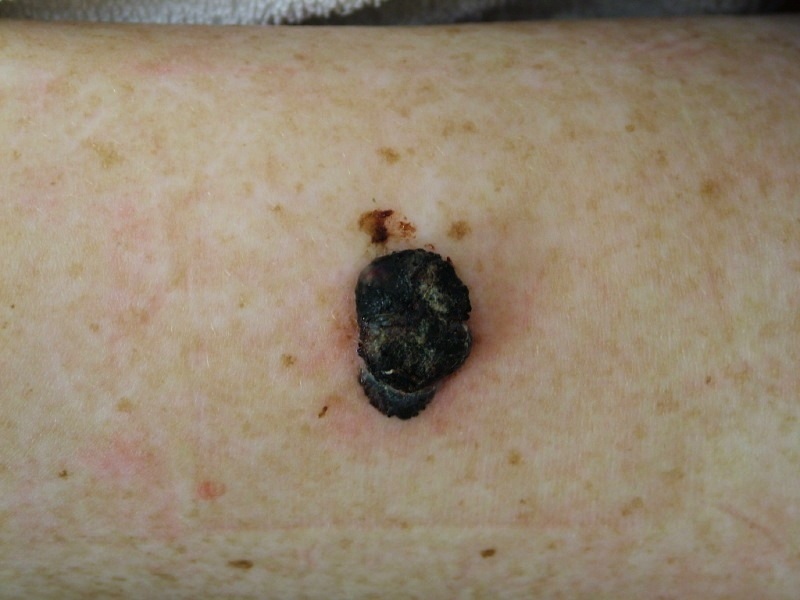Nodular melanoma is a type of skin cancer that develops when the cells that produce pigment in the skin grow abnormally and uncontrollably. It is the second most common type of melanoma, accounting for approximately 15-30% of all melanoma cases. Unlike other types of melanoma, nodular melanoma grows quickly and often presents as a raised, dark-colored bump on the skin. In this article, we will discuss the symptoms, causes, diagnosis, treatment, prevention, and prognosis of nodular melanoma.
What is Nodular Melanoma?
Nodular melanoma is a type of skin cancer that develops in the cells that produce pigment in the skin. It is characterized by its rapid growth and the formation of a raised, dark-colored bump on the skin. Unlike other types of melanoma, nodular melanoma does not typically develop from an existing mole.
Symptoms and Characteristics of Nodular Melanoma
Nodular melanoma often presents as a dark-colored bump on the skin that is raised and dome-shaped. The bump may be black, brown, or blue-black in color and may bleed or scab over. Other symptoms of nodular melanoma may include itching, tenderness, or pain in the affected area.
Causes and Risk Factors for Nodular Melanoma
The exact cause of nodular melanoma is not known, but it is thought to be related to genetic mutations that occur in the cells that produce pigment in the skin. Risk factors for nodular melanoma include a history of sunburn or excessive sun exposure, a family history of melanoma, a weakened immune system, and fair skin.
Diagnosis and Staging of Nodular Melanoma
Nodular melanoma is typically diagnosed through a skin biopsy, in which a small sample of the affected skin is removed and examined under a microscope. If the biopsy confirms the presence of nodular melanoma, further tests may be conducted to determine the stage of the cancer and whether it has spread to other parts of the body.
Treatment Options for Nodular Melanoma
The treatment of nodular melanoma depends on the stage of the cancer and the patient’s overall health. Treatment options may include surgery to remove the cancerous tissue, radiation therapy, chemotherapy, immunotherapy, or a combination of these treatments.
Prevention and Early Detection of Nodular Melanoma
The best way to prevent nodular melanoma is to protect your skin from the sun’s harmful UV rays by wearing protective clothing, using sunscreen, and avoiding excessive sun exposure. Early detection of nodular melanoma is also important for improving the prognosis and survival rate of the disease. Regular skin checks and self-examinations can help to identify any suspicious moles or bumps on the skin.
Living with Nodular Melanoma
Coping Strategies and Support
A diagnosis of nodular melanoma can be overwhelming and frightening. It is important to seek out support and coping strategies to help you manage the emotional and physical challenges of living with cancer. This may include seeking out a support group, talking to a mental health professional, or engaging in activities that promote relaxation and stress relief.
Latest Research and Advances in Nodular Melanoma Treatment
Research into the treatment of nodular melanoma is ongoing, and there have been significant advances in recent years. These include the development of new immunotherapies and targeted therapies that are designed to specifically attack cancer cells while sparing healthy cells.
Nodular Melanoma vs Other Types of Melanoma:
What’s the Difference? While all types of melanoma are serious and require prompt treatment, nodular melanoma has distinct characteristics that set it apart from other types of melanoma. Nodular melanoma typically grows more quickly than other types of melanoma and presents as a raised, dark-colored bump on the skin, rather than an existing mole. Nodular melanoma may also have a poorer prognosis than other types of melanoma if not detected and treated early.
Nodular Melanoma Survival Rates and Prognosis
The prognosis for nodular melanoma depends on a number of factors, including the stage of the cancer at the time of diagnosis, the patient’s overall health, and the treatment options available. The five-year survival rate for nodular melanoma is approximately 70%, but this varies depending on the stage of the cancer. When nodular melanoma is diagnosed and treated in its early stages, the prognosis is generally good, with a high likelihood of complete remission.
Conclusion:
In conclusion, nodular melanoma is a serious type of skin cancer that requires prompt diagnosis and treatment. Symptoms of nodular melanoma include the development of a raised, dark-colored bump on the skin that may bleed or scab over, as well as itching, tenderness, or pain in the affected area. Risk factors for nodular melanoma include a history of sunburn or excessive sun exposure, a family history of melanoma, a weakened immune system, and fair skin. Treatment options for nodular melanoma may include surgery, radiation therapy, chemotherapy, immunotherapy, or a combination of these treatments, and the prognosis for the disease depends on a number of factors, including the stage of the cancer at the time of diagnosis and the patient’s overall health. Preventative measures such as regular skin checks and sun protection can help reduce the risk of developing nodular melanoma, and ongoing research into the treatment of the disease continues to yield promising results.
